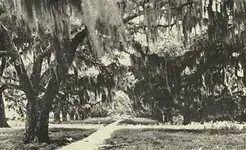Re: LOUISIANA BAYOU HUNT - DATE SET - APRIL '08 !
The Story of Spanish Moss
Spanish Moss (Tillandsia usneoides) is an air-feeding plant or epiphyte found mainly upon cypress, gum trees, oaks, elms, and pecan trees in South Louisiana and Florida. It is not a parasite and does not live off the trees upon which it grows, nor is it harmful to the trees. It has been noticed, however, that its presence on pecan trees tends to reduce the yield, owing, no doubt, to the fact that to some extent it shadows the buds of the
fruit.
When the French first came to Louisiana they asked the Indians what this hair-like plant was and were told thatit was "tree hair," or 'Itla-okla," as they called it. The French thought it reminded them of the long black beards of the Spanish explorers who had come before them, and advised the Indians that a better name was "Spanish Beard, " or "Barbe Espagnol. " The Spaniards, consider- ing this a term of ridicule, asserted that a more appropriate name was "Cabello Francés," or "French Hair." The Indians thought "Barbe Espagnol" sounded better and for many years Louisiana moss was referred to only as "Spanish Beard." But this name did not last; it seemed too ridiculous. The accepted name became Spanish moss.
The Area in Which Moss Grows
This moss grows in the area comprising the extreme southern portion of Virginia and the Gulf Coast country from Florida to Texas in varying quantities. But its yield in commercial quantities is in the lower Mississippi Valley, and especially in the swamp lands of Louisiana and Florida or where the rainfall is heavy. Louisiana has an annual average precipitation of about 56 inches, and Florida has nearly as much. While high temperatures and high relative humidity are favorable to the growth of moss, it can stand extremes of cold and drought for long periods.

This grove of oaks at Chalmette, just below New Orleans, is believed to be the finest in existence. The date the 79 trees were planted is uncertain but it is supposed that they are 150 years old. They served as a canopy from the Mississippi River, which was the principal artery of transportation, to the Chalmette plantation home, part of the walls of which is still standing. Chalmette was the scene of the Battle of New Orleans -- 1812. Spanish moss hangs like long beards from the trees. It has not retarded their growth.
Propagation
Spanish moss is not propagated by seeds but by fragments or festoons. These fragments are carried from tree to tree by birds and the winds. Birds frequently use strands of moss in building their nests, and in this way distribute the festoons. Evergreen trees seldom have moss on them, for the green leaves tend to ward off the festoons carried by the winds or dropped by birds. In the fall and winter when the trees lose their leaves, fragments of moss attach themselves to the bark. A moss which springs from a festoon or fragment grows to a great length, often reaching 10 to 20 feet. In the early summer this plant produces a very small yellow flower, hardly visible to the naked eye. Moisture and dust from the air produce all the nourishment necessary to keep the plant alive and growing. The plant absorbs water readily; it is, in fact, about twenty-five percent water.
Uses of Moss
The fibre of SPANISH MOSS was originally used in Louisiana for mattresses, and in upholstering, and as a hinder in the construction of mud and clay chimneys. It was also used extensively for binding mud or clay in plastering houses. In more recent years it is used almost exclusively as a filler in overstuffed furniture and upholstery. Probably less than one per cent of the total commercial moss is now used in the manufacture of mattresses. Its use in mattresses is confined to the southern part of Louisiana, usually in the suburban and rural sections.

This building on Bourbon Street, New Orleans, was erected in 1806 as a combination residence and business establishment. Today it is the famous Absinthe House, Spanish moss was used as a binder for the plaster. This moss is in good condition today, after 153 years. Moss fiber seems to be everlasting.
SPANISH MOSS (before and after curing) consists of an outer bark of a greyish color which protects the fibre within. This bark is mostly sap and vegetable matter and decomposes very rapidly when moistened sufficiently and placed into piles. Within this bark is a very resilient, wiry fibre which is the commercial moss used in overstuffed furniture, upholstery, mattresses, automobile seats, and cushions of various kinds.
Demand for Spanish Moss in Recent Years
In 1927 about 1200 carloads of Spanish moss were shipped out of Louisiana, valued at about $2,500,000. In 1940 about 500 carloads were shipped out of Louisiana, valued at about $750,000. This steady shrinkage in demand is owing primarily to increased use of cheaper imported fibres, such as sisal from Mexico, and the increased use of resilient rubber pads made in America. The State of Florida, where moss is also produced, has captured some of Louisiana's moss trade but not much. It is estimated that at the present rate of decline the moss industry of Louisiana will be negligible by 1961, unless there is a promotional campaign of some kind organised to increase the demand.
Beginning of Commercial Use
From the best information available, shipments of moss on a commercial scale began shortly after the War Between the States, when the upholsterers in the furniture trade began to use it in considerable quantities. This trade continued, and has been greatly increased since the value of moss became better known.
Difference in Strength of Fibre
In the lower sections of Louisiana green moss has a light coat of bark and a heavy and longer fibre. In the upper sections (over 100 miles from the Gulf) the bark is heavier, probably as a protection against colder weather, and the fibre is much lighter, shorter, weaker, and not as strong as the fibre from moss of the lower and more swampy section.
Why Moss is Desirable for Stuffing
No known insect will attack moss fibre, eat, destroy or live within it. Moss ranks next to curled hair in resiliency. That is why it is desirable for use in upholstery. Owing to the large amount of waste matter and the resultant loss of weight with each handling, moss is, contrary to current opinion, not a cheap filler for furniture. It is used only in the finest and most expensive furniture or cushions.
Is Moss Edible?
Spanish Moss fresh from the tree (before curing) is eaten by livestock during the winter months in much the same manner that hay is consumed. The outer bark of the strands (of a greyish color) probably contains some nourishment but not much. The fibre within this bark has no nutritive value but it serves as bulk. It is very doubtful that any animal could survive on a diet of green moss alone.
The Curing Process
Moss is grey when it comes from the tree; its color is a greyish white. It appears to be soggy or damp. In this condition it is unfit for commercial use. Only the black, hair-like strands (after being cured) are fit for commercial use. Curing is a long process. Some moss merchants or gatherers make mounds of the moss about five feet high and ten feet around. It is kept damp so as to cause the bark to decay and leave the fibre or hair-like strands free and firm. When this bark begins to peel off, the moss is either spread out or hung on the fence to dry so that it can be ginned. Other merchants or gatherers dig a pit and place the moss in it, thus hastening the decay of the outer coating or bark. It is then treated the same as the moss cured by the mound method before it is ready for ginning. The curing process by either method requires from three to four months. The curing of moss reduces the weight by approximately 75 per cent.
The bark or outer coating of the moss rescued in the curing and ginning is a very valuable by-product used as a mulch along with ordinary soil.
The waste matter in rough and cured moss will vary from 35 per cent to 75 per cent, and consists mainly of earth, sticks or twigs, dust, dried bark or husk, leaves and weak fibre. Owing to this waste matter almost every handling of rough moss entails a loss in weight. In recent years this waste after being well rotted from 5 to 8 years is useful as a mulch around azaleas, rose bushes, and other kinds of horticultural plants.









